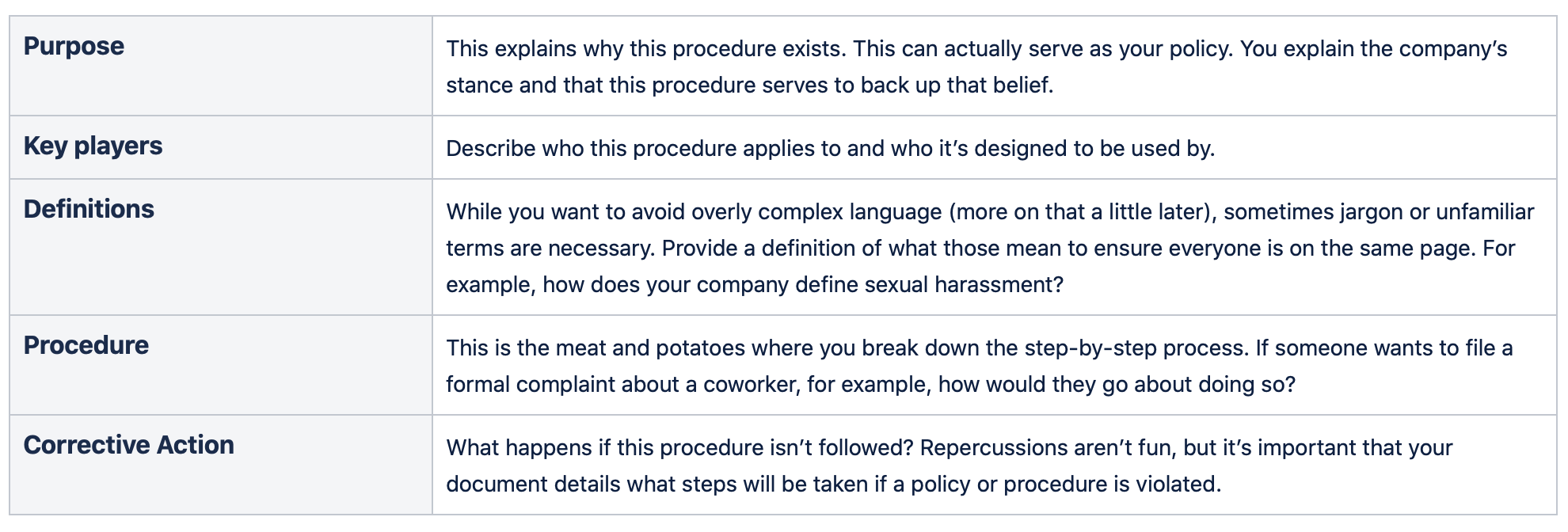HR policies and procedures
By Kat Boogaard

Documenting a company’s policies and procedures may not be a thrill for you (or maybe it is?), but you know how important it is for ensuring your office is a positive and safe place to work for everyone. Plus, having resources that your employees can refer to can offload quite a bit of work from your own plate.
Yet, far too many organizations push this task to the back burner. A 2015 survey from Business Process Trends showed that only 4% of companies claim that they always document their processes.
We get it. Whether you’re starting totally from scratch or with a manual that hasn’t seen any updates since 1996, putting how you do it into an organized and readable document sounds like a chore.
That’s where this guide comes in. We’ve broken down everything you need to know about documenting your organization’s policies and procedures below.
Bucket 1
Salary & Wages
Document all policies and procedures that relate to employee pay. This would include your guidelines for:
- Payment schedule
- Payment methods
- Promotions
- Raises
- Bonuses
- Performance reviews
Bucket 2
Personal Conduct
This category captures a variety of behaviors and interpersonal conflicts that could arise in the workplace, including:
- Discrimination
- Sexual harassment
- Nepotism
- Conflicts of interest
- Confidentiality
- Dress code
- Break time
- Social media, Internet, and phone usage
Bucket 3
Benefits
Your company’s benefit offerings might be confusing for some, so document it all in this bucket:
- Health insurance
- Dental insurance
- Vision insurance
- Disability insurance
- Retirement investments
- Employee assistance program
- Flexible spending account or health savings account
- Stock options
- Life insurance
- Professional development
- Perks and extras
- Paid leave (including vacation time, sick time, jury leave, funeral, maternity, and more)
Bucket 4
Recruitment & Retention
It’s valuable to document procedures for hiring and terminating of employees to help your company navigate what can be sensitive issues. Include things like:
- Hiring process
- Performance improvement process
- Termination process
- Recruiting guidelines
- Equal opportunity employment rules
- Interview expenses
- Relocation expenses
- Pre-employment tests
- Instructions for internal applicants
Bucket 5
Health & Safety
Ensure that every employee feels happy, safe, and supported in your work environment. That’s where this category comes into play. It encompasses items like:
- Weapons
- Emergency response
- Drug testing
- Inclimate weather response
This is by no means a comprehensive list, but it should help to get your wheels turning about what issues need to be addressed within your policies and procedures.
It can also be helpful to reflect on past personnel scenarios or think about potential issues that could crop up within your office. If you don’t already have a procedure that could apply to those circumstances, it’s worth getting one documented.
There’s a lot here, but rest assured that not all of these will be lengthy and complex. And, in most cases, the majority of these policies and procedures will be pulled together into a single employee handbook that your staff can reference when they need it.

Tip 1
Use clear language
It’s hard enough to get your employees to refer to your policies and procedures, but it’s even tougher if they need to wade through all sorts of complex language, jargon, and acronyms. So, make the information as straightforward as possible and leave less room for interpretation.
Tip 2
Ensure adequate document control
Your policies and procedures aren’t a “set it and forget it” type of thing. They’ll need constant refreshing and updating.
Use Jira Core to manage the process. It lets you set up simple workflow management for getting your updates drafted, reviewed, and approved.
Once your updates are approved and your new documents are live, keep everyone assured that they’re reading the latest version. Make sure the document shows:
When that document was originally created
When it was last updated
When it was last distributed
That allows everybody to have a solid grasp on how relevant that information is and if they should be looking out for new steps or details.
Keeping your employee handbook up to date can be a challenge. Use Trello boards to build an adaptable, scalable employee manual that looks great.
Tip 3
Make it easy to use
We’ve all seen it happen: employees are given a huge binder on their first day of work and it’s immediately relegated to their bottom desk drawer to spend a lifetime collecting dust and stray paperclips.
Those days are (or should be) long gone. Instead, set up your policies and procedures in an easy-to-reference and searchable way. Digitize them so that they’re accessible and simple to navigate (and don’t require endless sheets of paper!).

Use Confluence to create policies and procedures that are easy to reference – and collaborate on!
Tip 4
Confirm receipt
Your policies and procedures don’t do any good if no one reads them. They also don’t offer much legal protection if you don’t have proof that your employees actually received them.
Have employees sign and date a document that indicates that they received, reviewed, and understand the information. Does that guarantee they’ll actually read the documents? Not necessarily, but at least you’ll eliminate the inevitable, “I never knew that!” excuse that often crops up regarding policies.

